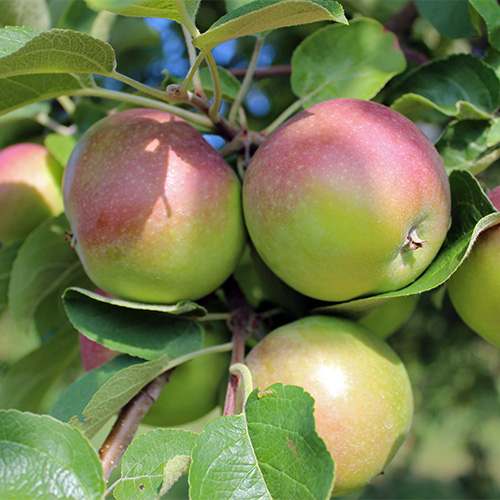
Jersey Mac Apple Tree
Origin: USA
Description:The Jersey Mac Apple Tree is an early season variety that is often used as a summer substitute for the more well-known McIntosh. It has a vigorous growth pattern and adapts well to a variety of climates, making it a versatile choice for apple growers. The trees structure is dense, with a rounded crown that facilitates sunlight penetration and air circulation, enhancing fruit color and quality.
Fruit: Jersey Mac apples are medium-sized with a bright red skin that has green undertones. The flesh is white and crispy, offering a tart flavor that mellows slightly as the fruit ripens. It is excellent for fresh consumption and also performs well in baking and cooking.
Harvest: The Jersey Mac is one of the first apple varieties to ripen, with harvests beginning in late July to early August. It yields abundantly, producing large quantities of fruit even at a young age.
Pollination: This variety benefits from cross-pollination with other apple varieties. Recommended pollinators include McIntosh, Honeycrisp, and Empire for best fruit production.
Spacing: Trees should be spaced approximately 3 to 4 meters apart. Jersey Mac trees are medium-sized, typically reaching heights of 3 to 4 meters. The smaller stature allows for easier management and harvesting.
Good to know: Jersey Mac apples have a relatively short storage life, which makes them ideal for immediate sale and consumption. However, their early ripening makes them valuable in markets that desire early season apples. Additionally, its hardiness and adaptability to various growing conditions make it a favored choice among new and experienced growers alike.
ask prices
- We only sell bare root trees to countries in Europe. We can't export potted trees due to trade regulations.
- We can deliver the trees to all countries in Europe and some countries in Eurasia and Middle East. We can arrange a truck to deliver the trees to your country.
- We are a wholesale nursery. Our minimum order quantity is 3.000 trees. Please note that we don't take orders below this limit.
- Phytosanitary certificates are provided with all orders. These certificates prove the origin of the trees and certify that they are free of diseases.
MM 9 (Dwarf)
M 9 is a dwarf rootstock suitable for high-density planting. It is resistant to the crown rot disease and moderately sensitive to the fire blight and wooly aphid. It is resistant to the illness of the tree tree and mildly susceptible to the blight of flames and wooly aphid. Throughout cultivation, it requires support systems. It should not be grafted on spur-type varieties such as Scarlett Spur, Redchief and Starkspur Golden. For the field, it should be recommended without limiting watering. It is moderately resistant to calcareous and heavy-textured soils. High crop quality, early fruit bearing and elevated efficiency out of a unit region within a brief span of moment are the most advantageous features M 9 offers to the plants.
MM 106 (Middle size)
It is a semi-dwarf rootstock, resistant to wooly aphid and is highly sensitive to disease of crown rot. For heavy-textured and argillaceous soils, it should certainly not be suggested. It has a closer and heavier root structure than rootstocks M9 and M26. Although it is more resistant to the climate than rootstocks M9 and MM 26, it should be chosen for frequent watering plants.For the gardens where MM 106 is grown, support devices are not needed. Within three or four years after planting, it becomes commercially profitable.
MM 111 (Large)
It is a semi-dwarf rootstock bigger than M106 and smaller than standard seedling rootstock. It is resistant to the illness of crown rot, wooly aphid and heavy-textured, argillaceous, calcareous plants with a pH scale above 7. Depending on the circumstances of care, it becomes commercially profitable within four or five years. When early flowering is desired, M 9 may be recommended as the rootstock between the system in some cases. When grafted on spur form and low strength varieties, it provides stronger outcomes.






